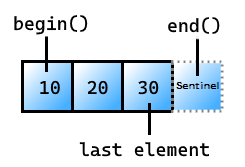Note
Access to this page requires authorization. You can try signing in or changing directories.
Access to this page requires authorization. You can try changing directories.
A view of the first N elements from another view.
Syntax
template<view V>
class take_view : public view_interface<take_view<V>>;
Template parameters
V
The type of the underlying range.
View characteristics
For a description of the following entries, see View class characteristics
| Characteristic | Description |
|---|---|
| Range adaptor | views::take |
| Underlying range | Any range |
| Element type | Same as the underlying range |
| View iterator category | Same as the underlying range |
| Sized | No |
Is const-iterable |
Only if the underlying range is const iterable |
| Common range | Only if the underlying range satisfies random_access_range and sized_range |
| Borrowed range | Only if the underlying range is borrowed_range |
Members
| Member functions | Description |
|---|---|
| Constructors | Construct the view. |
baseC++20 |
Get the underlying range. |
beginC++20 |
Get an iterator to the first element. |
endC++20 |
Get the sentinel at the end of the view. |
sizeC++20 |
Get the number of elements. The underlying range must satisfy sized_range. |
Inherited from view_interface |
Description |
backC++20 |
Get the last element. |
dataC++20 |
Get a pointer to the first element. |
emptyC++20 |
Test whether the view is empty. |
frontC++20 |
Get the first element. |
operator[]C++20 |
Get the element at the specified position. |
operator boolC++20 |
Test whether the view isn't empty. |
Requirements
Header: <ranges> (since C++20)
Namespace: std::ranges
Compiler Option: /std:c++20 or later is required.
Constructors
Construct an instance of a take_view
1) take_view() requires default_initializable<V> = default;
2) constexpr take_view(V base, range_difference_t<V> count);
Parameters
base
The underlying view.
count
The number of elements to take from the front of the underlying view. If count is more than the number of elements in the underlying view, the view will contain all the elements in the underlying range.
For information about the template parameter type, see Template parameters.
Return value
A take_view, which is a view of the first N elements from another view. If you specify more elements to drop than exist in the underlying range, an empty_view is returned.
Remarks
The best way to create a take_view is by using the views::take range adaptor. Range adaptors are the intended way to create view classes. The view types are only exposed in case you want to create your own custom view type.
1) Create a take_view that has no elements. The underlying view is default constructed. base() returns a copy of V().
2) Create a take_view from a base and a count. base is moved via std::move().
If count is less than the number of elements in the underlying range, then count determines the size of the take_view.
If count is greater than the number of elements in the underlying range, then the take_view includes all of the elements in the underlying range.
Example: take_view
// requires /std:c++20 or later
#include <ranges>
#include <iostream>
#include <vector>
int main()
{
std::vector<int> v{0, 1, 2, 3, 4, 5, 6};
auto newView = std::views::take(v, 3);
for (auto& e : newView)
{
std::cout << e << ' '; // 0 1 2
}
std::cout << '\n';
// Use the '|' operator to create a take_view
for (auto i : v | std::views::take(3))
{
std::cout << i << ' '; // 0 1 2
}
}
0 1 2
0 1 2
base
Gets a copy of the underlying view.
// Uses a copy constructor to return the underlying view
1) constexpr V base() const & requires std::copy_constructible<V>;
// Uses a move constructor to return the underlying view
2) constexpr V base() &&;
Parameters
None.
Return value
The underlying view.
begin
Get an iterator to the first element in the view.
constexpr auto begin() requires (!Simple_view<V>);
constexpr auto begin() const requires range<const V>;
Parameters
None.
Return value
An iterator pointing at the first element in the view.

Remarks
For 1, the Simple_view<V> requirement means that the view V and const V must have the same iterator and sentinel types.
end
Get the sentinel at the end of the view.
1) constexpr auto end() requires !(Simple_view<V>);
2) constexpr auto end() const requires range<const V>;
Parameters
None.
Return value
The sentinel that follows the last element in the view.

Remarks
For 1, the Simple_view<V> requirement means that the view V and const V must have the same iterator and sentinel types.
size
Get the number of elements.
constexpr auto size() requires sized_range<V>;
constexpr auto size() const requires sized_range<const V>;
Parameters
None.
Return value
The number of elements in the take_view.
If the take_view was constructed with an explicit count:
- if
countis less than the number of elements in the underlying range, it's returned as the size of the view. - if
countis greater than the number of elements in the underlying range, then the size of the view isranges::size(base).